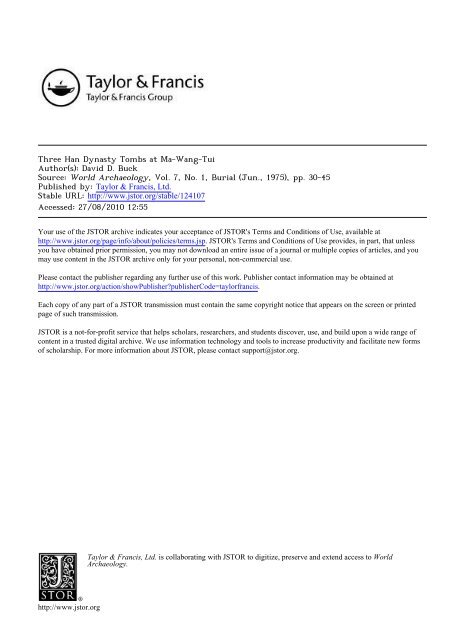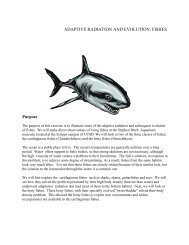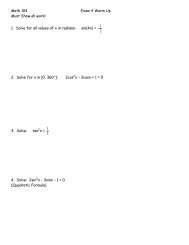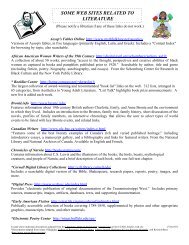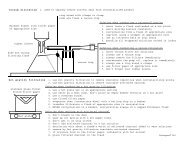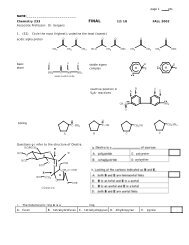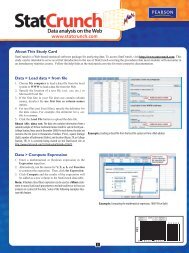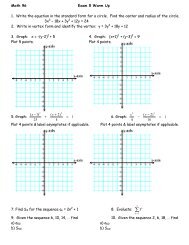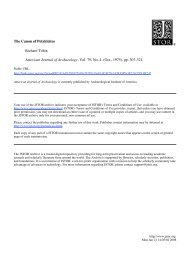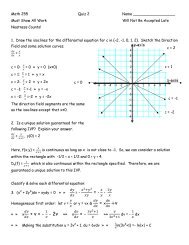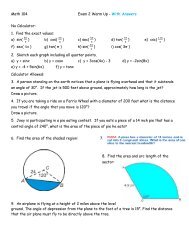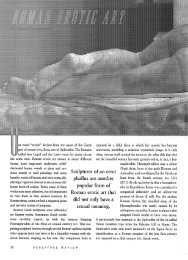You also want an ePaper? Increase the reach of your titles
YUMPU automatically turns print PDFs into web optimized ePapers that Google loves.
<strong>Three</strong> <strong>Han</strong> <strong>Dynasty</strong> tombs <strong>at</strong> <strong>Ma</strong>-wang-tui 31Museum also excav<strong>at</strong>ed a third tomb immedi<strong>at</strong>ely south of Tomb No. I. The discoveriesin Tomb No. 3 in many ways surpass those from Tomb No. I. The corpse in TombNo. 3 was not as well preserved as Lady Li's, but Chinese specialists have identified theskeleton as belonging to a young man in his thirties. Inscriptions in the tomb give hisde<strong>at</strong>h as occurring in i68 B.C. The man is believed to be the son of Li Ts'ang andHsin-chiu. The general construction of Tomb No. 3 is exactly the same as Tomb No. I,but the dimensions are slightly smaller. A second funerary banner, similar to the polychromepainted silk banner discovered in Tomb No. I, was included among the tombFigure I2 <strong>Ma</strong>-wang-tui, showing the loc<strong>at</strong>ion of the three tombs. Buildings to the south are partof the hospital complex which was constructed in I97I and brought about the opening of thetombs. Redrawn from Wen-wu (I974). 7: 40furnishings. Tomb No. 3 also contained a number of objects of gre<strong>at</strong> archaeological andhistorical interest not found in Tomb No. i. The walls of the outer burial chamber weredraped with painted silk cloths depicting processions and bo<strong>at</strong>ing expeditions. Thetomb's furnishings included thirty-eight different military weapons, ranging from swordsto bows and arrows. Also included were maps, the earliest yet found in China, andtre<strong>at</strong>ises on medical m<strong>at</strong>ters along with accompanying illustr<strong>at</strong>ions (Hunan I974).Most important of the finds in Tomb No. 3 are the texts of several ancient booksincluding the I ching (Classic of Changes), Chan-kuo tse (Intrigues of the Warring St<strong>at</strong>es)
32 David D. Buckand two different editions of Lao Tzu's Tao-te ching (The Way and Its Power). Thesetexts were written on silk in the clerical script (li-shu) coming into common use in theearly Western <strong>Han</strong> period. The copies of Lao Tzu's classic have <strong>at</strong>tracted the gre<strong>at</strong>estinitial <strong>at</strong>tention because the versions from Tomb No. 3 show several vari<strong>at</strong>ions fromtoday's accepted texts. Some chapters of the copies in Tomb No. 3 show a different orderof verses and also incorpor<strong>at</strong>e opening and closing essays which were previously un-known (Hunan 1974). This marks the second major find in recent years of classical textsfrom graves of the early Western <strong>Han</strong> period. In 1972 <strong>at</strong> Lin-i in the north Chinaprovince of Shantung, a <strong>Han</strong> period grave was found to contain several importanttexts written on bamboo strips. Most significant were Sun Wu's Pingfa (The Art of War)and a copy of his descendant Sun Pin's previously unseen work by the same title (Buck1974). These textual discoveries <strong>at</strong> <strong>Ma</strong>-wang-tui and Lin-i have come to play animportant part in new interpret<strong>at</strong>ions of the significance of the tombsTomb-constructionStr<strong>at</strong>ific<strong>at</strong>ion <strong>at</strong> <strong>Ma</strong>-wang-tui reveals th<strong>at</strong> Li Ts'ang's tomb (No. 2) was constructedfirst. It had an oval-shaped pit with sloping walls leading to a wooden tomb-chamberplaced in the bottom of the shaft. The tomb-chamber itself was packed first in a layer ofcharcoal and then in an outer layer of fine white and yellow clay. The tomb-shaft wasfilled with pounded earth and lastly a pounded-earth mound was raised over the mouth ofthe tomb-shaft. The tomb was oriented on a north to south axis and the tomb-passagewaylay to the north. Wooden tomb-guardian figures were found beside the passageway. LiTs'ang's tomb, however, was the earliest and least elabor<strong>at</strong>e of the three <strong>at</strong> <strong>Ma</strong>-wang-tui.In addition, several grave robberies had destroyed many of its original qualities.The best example of the style of tomb construction <strong>at</strong> <strong>Ma</strong>-wang-tui is found in TombNo. I. Str<strong>at</strong>igraphic evidence shows th<strong>at</strong> Lady Li's tomb was the last to be constructed <strong>at</strong><strong>Ma</strong>-wang-tui, and its digging resulted in damage to the entryway guardians of her son'stomb. Moreover, the tomb-mound for her burial covers part of the mounds of both<strong>Tombs</strong> No. 2 and o. . 3 Thus it is clear th<strong>at</strong> she died after her son in I68 B.c. Based,on the evidence of the types of clay coin-represent<strong>at</strong>ions found in Lady Li's tomb,Chinese scholars have concluded th<strong>at</strong> she died sometime prior to 145 B.C. (Hunan 1973:I, 156-7).Tomb No. i has an oblong pit measuring 19-5 m. north to south and I7'5 m. east towest. The tomb extends for 20 m. from the top of the covering mound to the bottomof the shaft. The tomb-pit mouth is marked by four steps each about a metre in width,(pl<strong>at</strong>e i), and below these steps steep, slanted walls lead to a crypt-space <strong>at</strong> the bottom.Access to the crypt was by means of a sloped, stepped passage th<strong>at</strong> enters from the north.The tomb shaft and passageway were constructed through several metres of packed earthwhich had been added to increase the n<strong>at</strong>ural height of the original hillock. The cryptspaceand part of the tomb-shaft lie within the original hill (fig. 13). The tomb wasoriented towards the north and arranged so th<strong>at</strong> the corpse would lie with its head to thenorth.
hmbr hoeoerl hae s enfomaoe,i nigr.Inieth ue<strong>Three</strong> <strong>Han</strong> <strong>Dynasty</strong> tombs <strong>at</strong> <strong>Ma</strong>-wang-tui 33g. - * w w . w E Tomb mound. - *i... - l ...............' IPacked . . .*Xearth'.'.'','.'','.' . '.'.'.',' . . Packed earth, '-.'- a '.'.'.'.'.'.' a-.' ' . -^tomb pitOriginal earth3i
34 David D. BuckThe correct identific<strong>at</strong>ion of the various parts of the tomb-chamber, including thecaskets and coffins, proved to be a m<strong>at</strong>ter of considerable difficulty. It also is a m<strong>at</strong>ter ofsome importance, because funerary regul<strong>at</strong>ions prescribed the proper form of a burial.Shih Wei's opinion th<strong>at</strong> there were four inner coffins has finally gained acceptance(Doi I974; Shih 1972).The compartments between the tomb-chamber and the casket enclosure are dividedinto four sections and contain most of the tomb-furnishings. The large northern sectionwas draped with silk cloth and contained a large number of wooden figures, includingseveral <strong>at</strong>tired in ceremonial dress. This section also contained some pl<strong>at</strong>ters of food.This area was found upon opening to be flooded with a liquid containing mercury andvarious acidic and organic compounds. It is believed this might have been connectedwith <strong>at</strong>tempts to preserve the corpse, but its purpose is not entirely clear.The western compartment contained rolled m<strong>at</strong>s, along with a large number of plaitedbamboo cases and baskets. The cases bore the seal of the Overseer of <strong>Ma</strong>rquis Tai'sHousehold. They contained food, clothing, and two models of musical instruments(Hunan I973: I, 117-I8). The eastern chamber contained a large number of carved andpainted wooden tomb-figurines. The southern chamber contained more tomb-figurinesand a complete inventory of the tomb-furnishings recorded on bamboo strips. Inaccordance with the practices of Emperor Wen (r. I79-I56 B.C.), Tomb No. I containedno precious metals, jade, or jewellery.A layer of charcoal o04 to 0o5m. thick was placed outside the tomb-chamber andbeyond this the crypt space was filled with <strong>at</strong> least a metre of fine white clay. Themarvellous st<strong>at</strong>e of preserv<strong>at</strong>ion of the contents of the tomb is <strong>at</strong>tributed primarily to theuse of the white clay and charcoal, which effectively kept out moisture and oxygen. Thepractice of using white clay around the outside of tombs and caskets is associ<strong>at</strong>ed withthe Ch'u culture. The addition of charcoal is a distinguishing characteristic of the earlyWestern <strong>Han</strong> tombs of the Ch'ang-sha area. In I96I a tomb, possibly th<strong>at</strong> of Wu Ching(d. I57 B.C.), the fifth and last member of the Wu family to hold the title of King ofCh'ang-sha, was opened in the suburbs of Ch'ang-sha and had the same combin<strong>at</strong>ion ofclay and charcoal (Bulling I974: i66). The stairs <strong>at</strong> the pit-mouth are anothercharacteristic fe<strong>at</strong>ure of early Western <strong>Han</strong> tombs in Ch'ang-sha.In other parts of the <strong>Han</strong> empire tomb-construction followed different practices.Some graves were constructed with long pits and the deceased remains were placed inrear niches. <strong>Tombs</strong> of members of the royal family in north China d<strong>at</strong>ing from the l<strong>at</strong>esecond century B.C. show an entirely different style, with large chambers hewn fromstone and linked by connecting passages. Such tombs <strong>at</strong> <strong>Ma</strong>n-ch'eng belonged to LiuSheng and his wife. Liu Sheng was the elder brother of Emperor Wu (r. I40-87 B.C.)and died in 113 B.C. His tomb and th<strong>at</strong> of his wife both contained jade burial suits whichhave been on public display in China and elsewhere (Ku I973). The practice of notincluding jade and precious metals followed <strong>at</strong> <strong>Ma</strong>-wang-tui had thus been completelyabandoned half a century l<strong>at</strong>er.These few examples illustr<strong>at</strong>e the main characteristics of the tombs <strong>at</strong> <strong>Ma</strong>-wang-tui.First, the tombs reveal clearly the continu<strong>at</strong>ion of the strong cultural tradition of theCh'u st<strong>at</strong>e which had ceased to exist as a political entity in 223 B.C. Second, the Ch'uculture in the early second century B.C. had been modified by certain new practices
<strong>Three</strong> <strong>Han</strong> <strong>Dynasty</strong> tombs <strong>at</strong> <strong>Ma</strong>-wang-tui 35introduced by the <strong>Han</strong> feudal rulers and administr<strong>at</strong>ors. These new practices did not,however, see the wholesale replacement of Ch'u culture, but r<strong>at</strong>her adapted or refinedexisting regional cultural motifs. Third, the early Western <strong>Han</strong> period was obviously aperiod of wide swings in accepted practice in many various m<strong>at</strong>ters, including burialregul<strong>at</strong>ions. This would fit the picture we have from historical sources of a vigorous andexpansive new amalgam of Chinese imperial culture taking shape in the early Western<strong>Han</strong>, and more especially in the reign of Emperor Wu.Tomb No. I: the coffinsThe four coffins in the centre of the tomb-chamber are all finely constructed anddecor<strong>at</strong>ed. The outermost coffin is black lacquer outside and red inside, but otherwisedevoid of decor<strong>at</strong>ion. The third coffin has a black-painted background covered withcloud p<strong>at</strong>terns, among which fifty-seven different mythological scenes are interspersed.Some of the figures have human faces, but most common is an animal which adoptshuman postures, wears clothing, and is depicted engaging in human pastimes includinghunting, dancing and playing musical instruments. The official report adopts the term'demons' (kuai-shen) for these beasts. Their dress and actions, especially those of thefigures shown with antlers or with wolf heads devouring snakes, links them with religioustomb-guardian figures from the earlier Ch'u culture (Sun I973b).The second coffin is decor<strong>at</strong>ed with a red background overlaid with polychromecolours. These have run in some places, but detailed line drawings reveal th<strong>at</strong> the top,sides and ends of the coffin all bear elabor<strong>at</strong>e scenes. On the top a m<strong>at</strong>ched pair of hugecurving dragons, whose long necks coil back through their own tails, are being <strong>at</strong>tackedby a pair of tigers. On the left side of the casket a similar pair of dragons enclose in theircurving bodies a horse, tiger, huge bird and a man. One end section shows two moredragons; the other a pair of deer. The right side of the coffin has a painted abstractdesign of angles, curves and volutes in the same style as the rest of the coffin, but includesno identifiable animal shapes. The significance of these various scenes and designs hasyet to be explained.The last and innermost coffin is decor<strong>at</strong>ed with an overlay of s<strong>at</strong>in stitch embroidery.The top and sides were further embellished with fe<strong>at</strong>hers applied with glue to strips of anunder fabric. The style of this decor<strong>at</strong>ion fits contemporary descriptions of the ways inwhich the coffins of the nobility were prepared (Yu I973).Tomb No. i: the corpse of Lady LiInside the fourth coffin the corpse of Lady Li lay wrapped in twenty layers of shroudsand cloth. Bene<strong>at</strong>h these, the corpse was further bound with nine bands. Below the bandsthere were further shrouds and clothing. The corpse lay on its back, head towards thenorth in a fully extended position.The remarkable condition of the corpse permitted Chinese specialists to undertake
36 David D. Bucka full post-exhum<strong>at</strong>ion autopsy. The corpse measured 1r54 m. in height and weighed34*3 kgm. One account st<strong>at</strong>ed, 'This aristocr<strong>at</strong>ic woman was about fifty and had ledthe idle dissip<strong>at</strong>ed life of the exploiting classes. Well nourished, she had plenty ofsubcutaneous f<strong>at</strong> . .' (China Reconstructs I973: 32). The examin<strong>at</strong>ions also told a gre<strong>at</strong>deal about Lady Li's medical history. As a young woman she had borne children and wasaround fifty when she died. Her right forearm had been deformed as a result of animproperly set fracture, and she had also a distinct narrowing of the fourth lumbar space,a condition th<strong>at</strong> caused her to stand and walk in a bent posture. Her left lung contained acalcified tuberculosis foci. She suffered from schistosomiasis, gall stones, and there wasevidence of pin and whipworms in the intestinal tract. Lady Li had Type-A blood andher arteries showed the build-up of heavy plaques to the extent th<strong>at</strong> her left coronaryartery was three-quarters blocked by these arteriosclerotic plaques. The autopsy concludedth<strong>at</strong> she had probably died of myocardial infartion sometime shortly after e<strong>at</strong>ingmusk melon. Seeds of th<strong>at</strong> fruit were found in her esophagus, stomach and intestines(Hunan I973: I, 3I-2).The corpse also revealed how an aristocr<strong>at</strong>ic coiffure of the period was made, as wellas details of dress and adornment. Lady Li was wearing a bag of herbs around her neck.These herbs were among those prescribed for a certain illness in the Huang-ti neiching (The Yellow Emperor's Classic of Medicine).The corpse in Tomb No. 3 had decomposed leaving little more than the skeleton. Thelayer of white clay in Tomb No. 3 was much thinner than in Lady Li's tomb and this isbelieved to have permitted decomposition of the male corpse (Hunan 1974: 42).Funerary banners from <strong>Tombs</strong> No. i and 3Folded on the top of the innermost coffins in both <strong>Tombs</strong> No. I and No. 3 lay largeT-shaped silk garments decor<strong>at</strong>ed with elabor<strong>at</strong>e polychrome paintings (fig. i4).Several detailed commentaries on the design and purpose of this funerary banner fromTomb No. i have appeared, but no careful comparisons of the two banners have yet beenpublished. The general shape and design of the banner from Tomb No. 3 coincides,however, with th<strong>at</strong> from Tomb No. i (Hunan I974).In the tomb-furnishings register found in Tomb No. I this large silk banner isdescribed as a 'flying garment' (fei-i). Its place in the tomb corresponded to the prescribedloc<strong>at</strong>ion for funerary banners (ming-ching) displayed during funeral ceremonies andcarried in the funeral procession. The most s<strong>at</strong>isfactory analysis of the banner has beenadvanced by A. Gutkind Bulling who interprets the scenes painted on to the banner asdepicting the f<strong>at</strong>e of the human soul after de<strong>at</strong>h (I974).The banner from Tomb No. i has a painted red field which has turned a dark reddishbrown.The elabor<strong>at</strong>e design was painted over in heavy colours which have retained theirpigment<strong>at</strong>ion r<strong>at</strong>her well. The cross arm of the T is o092 m. long, the overall height is2-05 m., and the width <strong>at</strong> the bottom is 0-48 m. Tassels extend from the four lowercorners.The bottom section of the design depicts the underworld inhabited by snout-nosedfish, snakes and antlered animals th<strong>at</strong> resemble the demons (kuai-shen) from the third
<strong>Three</strong> <strong>Han</strong> <strong>Dynasty</strong> tombs <strong>at</strong> <strong>Ma</strong>-wang-tui 37inner coffin. Above the underworld lies the human realm. The figures on the pl<strong>at</strong>formsupported by the human-faced monster are members of the deceased's householdperforming some burial rituals. The central figure on the second pl<strong>at</strong>form is identifiedas Lady Li, <strong>at</strong>tended by five females. Ms. Bulling believes th<strong>at</strong> this scene represents the'Gre<strong>at</strong> Summoning' (Ta-chao) conducted after de<strong>at</strong>h in order to loc<strong>at</strong>e the spirit of thedeparted and to welcome it back into its former household for a short visit prior to itsfinal departure (I974: I65). In the banner from Tomb No. i the central figure on theraised pl<strong>at</strong>form is shown standing in a stooped position with a staff, as one would expectof a woman with the kind of back problems disclosed by the autopsy. In the bannerfrom Tomb No. 3 a young man is shown with five male <strong>at</strong>tendants on the same elev<strong>at</strong>edpl<strong>at</strong>form. The elev<strong>at</strong>ion represents the visit of the spirit back to its home before proceedingupwards into the realm of heaven. Above the heads of the small party on the elev<strong>at</strong>edpl<strong>at</strong>form on both banners a bird with a human face is shown flying along the upperreaches of the sky.Ms. Bulling has interpreted the two large, intertwining dragons th<strong>at</strong> extend along thesides of the lower section of the banner from Tomb No. i as represent<strong>at</strong>ions of the twoelements in the Chinese conception of the soul. These two elements will be reunited afterde<strong>at</strong>h and th<strong>at</strong> meeting will take place in a heavenly realm beyond the ken of mankind.Two guardians wait <strong>at</strong> the 1 1-shaped g<strong>at</strong>es of this heavenly realm. To the left a crescentmoon is shown with two animals, a hare with pupil-less eyes and a toad, both associ<strong>at</strong>edwith the moon in Chinese myths. Below is Chang Ngo, the goddess of the moon. To theright is the red sun inhabited by a mythological crow-like bird called chiin-niao.This birdwas believed to have had three legs, but is shown in both banners from <strong>Ma</strong>-wang-tuiwith only two legs. The bird was known primarily from literary sources, and the depictionson the funerary banners show th<strong>at</strong> it does have three-clawed feet: the literarytradition of a three-legged bird probably developed from the incorrect transcription of thecharacter for claw (chih).The centre of <strong>at</strong>tention in the upper part of the Tomb No. i banner is intended to bethe robed man with a long serpent's tail, <strong>at</strong>tended by five birds. Ms. Bulling identifiesthis figure with Fu-hsi or Tai-i, who, she says,represents the primordial ancestor to whom these two should return.... The souls returningto their origin having been divested of their human elements are now prepared for a new birth,not a repetition of the physical birth but a mystical re-birth as ancestor spirit, free of thelimit<strong>at</strong>ions of time and space, thus it is hoped able to come to the assistance of theirdescendants. (1974: 169)Additional tomb-furnishings<strong>Tombs</strong> No. i and No. 3 each contained over one thousand different items ranging frombamboo cases bound with hemp rope to funerary models of musical instruments andcoins. It is impossible to describe all these, but in general the furnishings can be dividedinto two groups. One group is common to both tombs and consequently represents theprescribed elements of a Western <strong>Han</strong> noble burial. The other group differs as betweenthe two tombs. The objects in the second group may either represent vari<strong>at</strong>ions in the
Figure 14 Line-drawing of polychrome painted design on the funerary banner from TombNo. i. Figure with walking-stick on the lower section of the T is taken to represent Lady Li whowas buried in the tomb. Copied from Ch'ang-sha <strong>Ma</strong>-wang-tui i-hao <strong>Han</strong>-mu (I973). I: 40
<strong>Three</strong> <strong>Han</strong> <strong>Dynasty</strong> tombs <strong>at</strong> <strong>Ma</strong>-wang-tui 39prescribed furnishings for the two sexes, or in the interests and tastes of the individualsconcerned.Examples of the common furnishings are the funerary models of a twenty-four stringzither (se) and a twenty-two pipe mouth-organ (yi) found in the western compartmentsof both tombs. Both tombs also contained large carved tomb-figures (up to 735 mm. inheight) representing <strong>at</strong>tendants, musicians and dancers, dressed in mini<strong>at</strong>ure courtcostumes and placed in the northern compartments of the tomb chamber. In addition, onthe top of the inner coffins, near the funerary banners, both tombs had groups of sticksof peach-wood, crudely carved with rudimentary faces and bound together with hemp.Both tombs also contained many varieties of food. The grains included rice, whe<strong>at</strong>, o<strong>at</strong>s,millet, soya beans and hemp seeds. The fruits and vegetables included plums, pears,jujube, and several kinds of greens. The me<strong>at</strong>s were especially plentiful, ranging fromox, sheep, pig, deer and dog, through duck, chickens and various other kinds of domesticand game birds.Examples of vari<strong>at</strong>ion on the basis of the deceased's sex can be found in the gender ofthe tomb figurines. The figures in Lady Li's tomb were primarily female; while those inher son's were mostly male. The inclusion of a lacquer gambling board and pieces in theman's tomb is probably another example of the same phenomenon. Lady Li's tombcontained no weapons, but her son's held over thirty different items of this kind.The maps, the medical tre<strong>at</strong>ises, and some of the articles of clothing found in TombNo. 3 probably reflect the personal interests of Lady Li's son. One map shows mountains,hills and settlements; another is specifically military in character, with garrisons anddistances clearly noted. There is a gauze-silk ceremonial cap contained in a speciallacquer box th<strong>at</strong> was probably one of the insignia of rank belonging to Lady Li's son.The inclusion of more than two hundred bamboo strips inscribed with medical inform<strong>at</strong>ionsimilar to th<strong>at</strong> contained in the first classic of Chinese medicine, Huang-ti nei ching,with the accompanying illustr<strong>at</strong>ions on silk, is another item probably of individualinterest (Hunan 1974).All the tomb-furnishings reflect a highly complex and str<strong>at</strong>ified society in the Ch'angshakingdom of the second century B.C. The region had long been noted as a centre ofhandicrafts, but the well-preserved silks, and the lacquerware in particular, reflect strongregional craft traditions th<strong>at</strong> maintained high standards in the early years of the <strong>Han</strong>dynasty. Most highly praised are the fine wine cups with small ear-like handles (fig. 15).Chinese descriptions of the tomb-finds have stressed the finds as evidence of the highlevels of skills among Chinese artisans in the second century B.C. The discoveries thusbecome evidence of the people's cre<strong>at</strong>ivity.Ch'u cultureThe cultural tradition of the Ch'ang-sha artisans was th<strong>at</strong> of Ch'u. The Ch'u peopleinhabited an area south-west of the gre<strong>at</strong> north China plain and in historical timesexpanded their power into the central Yangtze valley region, encompassing the presentdayprovinces of Hunan and Hupei. Ch'u became one of the three largest and mostpowerful contenders for power in the last years of the Warring St<strong>at</strong>es period during the
40 David D. Buckthird century B.C. Ch'u was conquered and destroyed in 223 B.C. by the generals of theCh'in st<strong>at</strong>e, who went on to unite China under Ch'in Shih Huang-ti, the first emperor.The first unific<strong>at</strong>ion of China lasted only a short while, from 22I to 207 B.C. After thefirst emperor's de<strong>at</strong>h rebellions broke out in the empire. A descendant from the gre<strong>at</strong>Hsiang military family of Ch'u quickly emerged as the most powerful man in China.Hsiang Yii was not, however, interested in cre<strong>at</strong>ing his own dynasty and, after destroyingthe remnants of Ch'in power, he declined the throne himself and declared a member ofthe Ch'u royal house to be the highest ruler in China. These events <strong>at</strong> the close of thethird century B.C. indic<strong>at</strong>e th<strong>at</strong> Ch'u was a strong and extremely vigorous branch ofChinese civiliz<strong>at</strong>ion.Two thousand years ago the present-day city of Ch'a-shang was an important settlementknown as Lin-hsiang, <strong>at</strong> the mouth of the Hsiang river. Lin-hsiang was a secondarycentre of Ch'u culture in the Warring St<strong>at</strong>es era; the capital of the Ch'u st<strong>at</strong>e lay acrossLake Yiin-meng (today's Tung-t'ing Lake), on the northern shore near the present-daycity of Chiang-ling (Huang and Niu I972).Unfortun<strong>at</strong>ely, few literary traces of Ch'u culture remain. The principal source is theCh'u tz'u (Songs of Ch'u) which contains distinctive poetry of the l<strong>at</strong>e Warring St<strong>at</strong>esperiod (Hawks I959). Most of our knowledge of Ch'u culture comes from the workof archaeologists. The extensive and careful excav<strong>at</strong>ions in the People's Republic of3 4Figure 15 Lacquer drinking-cups from Tomb No. I. Tu Nai-sheng believes the threecharacterinscription means something like 'Please drink the wine', couched in terms appropri<strong>at</strong>eto the high st<strong>at</strong>ion of the <strong>Ma</strong>rquis of Tai and his family (1973: 80). Copied from Ch'ang-sha<strong>Ma</strong>-wang-tui i-hao <strong>Han</strong>-mu (I973). i: 83. Approxim<strong>at</strong>ely two-fifths actual size
<strong>Three</strong> <strong>Han</strong> <strong>Dynasty</strong> tombs <strong>at</strong> <strong>Ma</strong>-wang-tui 41China in the past twenty-five years have contributed gre<strong>at</strong>ly to the increased <strong>at</strong>tentiongiven to the culture of Ch'u in recent accounts of ancient China. Although none of theCh'u st<strong>at</strong>e capitals has yet been excav<strong>at</strong>ed, the Ch'u burial sites have yielded largenumbers of beautiful lacquerware items, weapons, mirrors, wooden tomb-figurines andwooden monster-animals (Chang 1968 and 1972; Hayashi 1972).The people of Ch'u are believed to have been inclined more towards religion than theinhabitants of the north China plain. The role of the shaman (wu) in Ch'u culture appearsto have been quite important. The large numbers and distinctive character of the tombfurnishingsassoci<strong>at</strong>ed with Ch'u graves are believed to reflect the important role of theseshaman (Hayashi, I972). A gre<strong>at</strong> deal remains to be explained about the origin and n<strong>at</strong>ureof Ch'u culture, but it clearly had a major influence on the final syntheisis of Chineseimperial culture th<strong>at</strong> emerged in the Western <strong>Han</strong> dynasty. H. G. Creel has written,'In the eventual amalgam<strong>at</strong>ion th<strong>at</strong> produced the Chinese st<strong>at</strong>e and Chinese culture asthey have existed for the past two thousand years, it seems likely th<strong>at</strong> Ch'u contributedquite as much as it received' (I970: I29). The tombs <strong>at</strong> <strong>Ma</strong>-wang-tui represent a majorstep in the process when Ch'u culture was being synthesized into the newly emerging,dynamic culture of the Western <strong>Han</strong>. Much work remains to be done to distinguish theCh'u influence on the Western <strong>Han</strong>, but the discoveries <strong>at</strong> <strong>Ma</strong>-wang-tui are so rich andvaried th<strong>at</strong> they will provide one of the chief reference points in the work of understandingthe historical process of the cre<strong>at</strong>ion of imperial Chinese culture.Li Ts'angSome additional history of the Western <strong>Han</strong> will further illumin<strong>at</strong>e the significance of thetombs <strong>at</strong> <strong>Ma</strong>-wang-tui. After Hsiang Yii failed to establish a system for ruling China, oneof his subordin<strong>at</strong>es, Liu Pang, began the conquest of China. Liu Pang based himselfin the Wei valley, the area which had previously proved so advantageous for theCh'in, and in 202 B.C. his conquest had proceeded far enough for him to assume theimperial throne as the first emperor of the <strong>Han</strong> dynasty. He enfeoffed eight men askings (wang), in control of large territories loc<strong>at</strong>ed <strong>at</strong> some distance from his own powerbasein the Wei river valley.One of these new kings was Wu Jui, a former general, who received the kingdom ofCh'ang-sha. This policy of granting large territories did not prove to be an adequ<strong>at</strong>emeans for governing the empire and by 197 B.C. Liu Pang had removed all the originaleight kings except for Wu Jui in Ch'ang-sha. Liu Pang continued to cre<strong>at</strong>e kings andkingdoms, but granted these favours only to members of the royal family. At the timeof Liu Pang's de<strong>at</strong>h in 195 B.C. ten kingdoms existed; members of the Liu family heldnine. Only Wu Ch'eng, the son of Wu Jui, controlled a territory independent of theimperial line.Although the <strong>Han</strong> rulers did not remove the Wu family from power in the st<strong>at</strong>e ofCh'ang-sha for several more decades, they did increase their control over the kingdom byappointing a chancellor (ch'eng-hsiang). Li Ts'ang received this appointment in 193 B.c.Along with his chancellorship, Li Ts'ang also received a fief of 700 households and thetitle '<strong>Ma</strong>rquis of Tai'. The marquis<strong>at</strong>e of Tai lay <strong>at</strong> least o00 km. north of the city of
42 David D. BuckLin-hsiang and the tombs <strong>at</strong> <strong>Ma</strong>-wang-tui; as a consequence, the Li family had to live inLin-hsiang in order for the chancellor to fulfil his duties (Huang and Niu 1972).The available records do not tell us wh<strong>at</strong> fitted Li Ts'ang for his new post in Ch'angsha,but the emperor's reasoning in a similar appointment is recorded,'Ch'en Hsi,' said the Emperor [Liu Pang], 'formerly acted as my envoy, and I had the deepestfaith in him. Tai1 is a region of critical importance to me, and therefore I enfeoffed Ch'enHsi as a marquis and made him chancellor of the kingdom so he could guard if for me.'(Shih chi 8; W<strong>at</strong>son 196I: I, x12.)Ch'en Hsi revolted against the <strong>Han</strong>, but Li Ts'ang and his descendants proved to bemuch more loyal followers of the <strong>Han</strong> dynasty. Although it is not clear th<strong>at</strong> Li Ts'ang'sson succeeded him as chancellor in Ch'ang-sha, the size and opulence of <strong>Tombs</strong> No. iand No. 3 indic<strong>at</strong>e th<strong>at</strong> the Li family enjoyed increasing favour and wealth after LiTs'ang's de<strong>at</strong>h. The marquis<strong>at</strong>e of Tai remained in the hands of the Li family until10 B.C. <strong>Tombs</strong> of the l<strong>at</strong>er marquises have not been loc<strong>at</strong>ed. Regul<strong>at</strong>ions requiring theresidence of feudal lords in their fiefs or <strong>at</strong> the n<strong>at</strong>ional capital in Ch'ang-an underwentseveral revisions. It is possible th<strong>at</strong> other tombs of the Li family will be found in thevicinity of Ch'ang-sha or in the fief itself. The loc<strong>at</strong>ion of the l<strong>at</strong>ter is still not completelysettled, but is believed to be near the present-day Kuang-shan district in Hupei (HunanI973: I, I58).Significance of the <strong>Ma</strong>-wang-tui tombsThe Western <strong>Han</strong> period is one of the gre<strong>at</strong> form<strong>at</strong>ive periods of Chinese history. Afterthe first unific<strong>at</strong>ion by the Ch'in in 221 B.C., it required more than a century before th<strong>at</strong>unity became a workable reality. The burials <strong>at</strong> <strong>Ma</strong>-wang-tui show th<strong>at</strong> in the kingdomCh'ang-sha an apparently easy accommod<strong>at</strong>ion between the requirements of <strong>Han</strong> ruleand the continued existence of the Ch'u cultural tradition had been reached in the firsthalf of the second century B.C. These accommod<strong>at</strong>ions were to be overturned during thetime of Emperor Wu (r. 140-87 B.C.), but the tombs offer no clues to those l<strong>at</strong>er events.The tombs do reveal, however, the complexity and high craftmanship <strong>at</strong>tained withinthe Ch'u cultural tradition. Earlier excav<strong>at</strong>ions had indic<strong>at</strong>ed this, but the extraordinaryrichness and diversity of the <strong>Ma</strong>-wang-tui tombs has established this characteristic ofCh'u culture beyond all question. Interpret<strong>at</strong>ions of the tombs made in China havestressed how tomb-furnishings are actually the achievements of the working people andshow how the working people were exploited by the feudal aristocr<strong>at</strong>s (Hunan 1973: I,I60--).The Chinese interpret<strong>at</strong>ions of the tombs have also been involved in the currentre-evalu<strong>at</strong>ion of the historical roles of Confucius and Ch'in Shih Huang-ti. The l<strong>at</strong>terordered the burning of books, including the Confucian classics, after his unific<strong>at</strong>ion ofChina. Until recently, Chinese and foreign historians have alike generally looked uponCh'in Shih Huang-ti's actions as a totalitarian effort to destroy China's gre<strong>at</strong> heritage ofConfucian philosophy in favour of the narrow and harsh dict<strong>at</strong>es of Legalism.Written with another character, and hence a different place from the marquis<strong>at</strong>e of Tai.
<strong>Three</strong> <strong>Han</strong> <strong>Dynasty</strong> tombs <strong>at</strong> <strong>Ma</strong>-wang-tui 43Today in the People's Republic, Ch'in Shih Huang-ti's actions receive a markedlydifferent interpret<strong>at</strong>ion. His suppression of the old philosophical traditions is applaudedas a necessary step when China was moving from a slave to a feudal society. On the otherhand, Confucius and his followers, who lived in the period of transition from a slaveto a feudal society, are condemned as conserv<strong>at</strong>ives who hoped to restore slave culturewhen the economy was progressing beyond such a mode of production. Confucians ofthe feudal period are criticized today for the reactionary n<strong>at</strong>ure of their philosophicalpositions.By the time of the second century B.C. and the <strong>Ma</strong>-wang-tui tombs, the process ofeconomic change from slave to feudal society had gone so far th<strong>at</strong> a true restor<strong>at</strong>ion ofslavery was impossible, yet it was still a time of fierce struggle between the contendingphilosophies of slave and feudal society. According to recent Chinese commentaries,the upper classes of the Western <strong>Han</strong> were beguiled into believing th<strong>at</strong> the preserv<strong>at</strong>ionof outmoded philosphical ideas was valuable. Consequently, the discoveries <strong>at</strong> the <strong>Ma</strong>-wang-tui tombs are said to 'indic<strong>at</strong>e the upper classes in the kingdom of Ch'ang-shaduring the early Western <strong>Han</strong> continued to strive to maintain the old rites' and the burialcustoms followed reflect the influence of the slave tradition and the tenacity of thereactionary ideology of slavery in the feudal era (Hunan I974).This argument, with its emphasis on the tenacity of old, outmoded philosophies, andon the dangers of revisionism or reactionary ideas reasserting themselves, is obviouslyladen with analogies to China's present internal situ<strong>at</strong>ion. These comparisons arefrequently and thoroughly discussed in various articles. The efforts of anti-Confucianleaders are praised and the defenders of Confucianism are roundly criticized. In thisfashion the discoveries <strong>at</strong> <strong>Ma</strong>-wang-tui have been brought into the realm of currentpolitical discussion as a case illustr<strong>at</strong>ing the tendency for ruling elites to make the mistakeof revering and preserving cultural forms and cre<strong>at</strong>ions th<strong>at</strong> are truly no longer desirableor healthy for society.These new characteriz<strong>at</strong>ions of the Warring St<strong>at</strong>es and Western <strong>Han</strong> period willencounter considerable disagreement from foreign scholars. Nevertheless they, like theChinese, will be engaged in an effort to understand more fully the meanings of the textsand artefacts found in the <strong>Ma</strong>-wang-tui tombs, and to rel<strong>at</strong>e those finds to the process ofthe cre<strong>at</strong>ion of the Chinese Imperial civiliz<strong>at</strong>ion th<strong>at</strong> was occurring in the Western <strong>Han</strong>dynasty.30.xii. 974 University of WisconsinMilwaukeeReferencesAn, Chih-min. I973. Ch'ang-sha hsin fa-hsien te hsi-<strong>Han</strong> po-hua shih-t'an. K'ao-ku. I24:43-53.Buck, D. D. I974. Discovery of Pre-<strong>Han</strong> Texts <strong>at</strong> Lin-i (Shantung). Newsletter of Society forthe Study of Pre-<strong>Han</strong> China. 4:2-6.Bulling, A. Gutkind. I974. The Guide of the Souls Picture in the Western <strong>Han</strong> Tomb in<strong>Ma</strong>-wang-tui near Ch'ang-sha. Oriental Art. 20:158-73.
44 David D. BuckChang, Kwang-chih. I968. The Archaeology of Ancient China. Revised edition. New Haven.Chang, Kwang-chih. 1972. <strong>Ma</strong>jor aspects of Ch'u archaeology. In N. Barnard, ed. EarlyChinese Art and its Possible Influence in the Pacific Basin. New York. 1:5-52.China Reconstructs. I973. Autopsy of corpse from <strong>Han</strong> Tomb No. i <strong>at</strong> <strong>Ma</strong>-wang-tui. 22.10:32-4.Ch'ii, T'ung-tsu. I972. <strong>Han</strong> Social Structure. Se<strong>at</strong>tle.Creel, H. G. 1970. The Origins of St<strong>at</strong>ecraft in China. Chicago. 1:217-28.Doi, Yoshiko. I973. <strong>Ma</strong>-o-tai ichigo kanbo ni tsuite. Kobijitsu. 42:93-8.Doi, Yoshiko. I974. Sono <strong>at</strong>o no <strong>Ma</strong>-o-tai ichigb kanbo. Kobijitsu. 44:II7-27.Hawks, D. I959. Ch'u Tz'u, The Songs of the South. Oxford.Hayashi, Minao. 1972. The Twelve Gods of the Chan-kuo period silk manuscript excav<strong>at</strong>ed<strong>at</strong> Ch'ang-sha. In N. Barnard, ed. Early Chinese Art and its Possible Influence in the Pacific Basin.New York. 1:123-86.Huang, Sheng-chang and Niu, Chung-hsiin. 1972. Kuan-yii Ch'ang-sha <strong>Ma</strong>-wang-tui <strong>Han</strong>-mute li-shih ti-li wen-t'i. Wen-wu. I96:22-9.Hunan Provincial Museum. I959. Ch'ang-sha Ch'u-mu. K'ao-ku hsiieh-pao. 1:41-68.Hunan Provincial Museum and Institute of Archaeology, Academia Sinica. 1972. Ch'ang-sha<strong>Ma</strong>-wang-tui i-hao <strong>Han</strong>-mu fa-chiieh chien-pao. Peking: Wen-wu ch'u-pan she.Hunan Provincial Museum and Institute of Archaeology, Academia Sinica. I973. Ch'ang-sha<strong>Ma</strong>-wang-tui i-hao <strong>Han</strong>-mu. Peking: Wen-wu ch'u-pan she.Hunan Provincial Museum and Institute of Archaeology, Academia Sinica. I974. Ch'ang-sha<strong>Ma</strong>-wang-tui erh, san hao <strong>Han</strong>-mu fa-chiieh chien-pao. Wen-wu. 218:39-48.Institute of Archaeology, Academia Sinica, and Hunan Provincial Museum. 1974. <strong>Ma</strong>-wang-tui<strong>Han</strong>-mu te tsang-chih yii hsi-<strong>Han</strong> ch'u-ch'i fu-p'i fan-fu-p'i tou-cheng. K'ao-ku. 133:209-I4.Ku, Yen-wen. I973. <strong>Han</strong> <strong>Tombs</strong> <strong>at</strong> <strong>Ma</strong>ncheng. In Hsia Nai, ed. New Archaeological Finds inChina. Peking. 14-20.<strong>Ma</strong>, Yung. 1972. Tai hou ho Ch'ang-sha ch'eng-hsiang. Wen-wu. 196:14-21.Shih, Wei. 1972. Ch'ang-sha <strong>Ma</strong>-wang-tui i-hao <strong>Han</strong>-mu te kuan-kuo chih-tu. K'ao-ku.I23:48-52.Ssu-ma, Ch'ien. Shih-chi. Peking: Chung-hua shu-chi. I959 edition in io volumes.Sun, Tso-yun. I973. Ch'ang-sha <strong>Ma</strong>-wang-tui i-hao <strong>Han</strong>-mu ch'u-t'u hua-fan k'ao-shih.K'ao-ku. 124:54-61.Sun, Tso-yun. 1973b. <strong>Ma</strong>-wang-tui i-hao <strong>Han</strong>-mu ch'i-kuan hua k'ao-shih. K'ao-ku. I27:247-54.T'ang, Lan, et al. 1972. Tso-t'an Ch'ang-sha <strong>Ma</strong>-wang-tui i-hao <strong>Han</strong>-mu. Wen-wu. I96:52-73.Tu, Nai-sheng. 1973. <strong>Tui</strong> 'chiin hsing chiu,' 'chiin hsing shih' te chieh-shih. Wen-wu. 208:80.Yu, Hsing-wu. I973. Kuan-yii Ch'ang-sha <strong>Ma</strong>-wang-tui i-hao <strong>Han</strong>-mu nei-kuan kuan-shih techieh-shou. K'ao-ku. I25:126-7.W<strong>at</strong>son, B. i96I. Records of the Grand Historian of China. New York.
<strong>Three</strong> <strong>Han</strong> <strong>Dynasty</strong> tombs <strong>at</strong> <strong>Ma</strong>-wang-tui 45AbstractBuck, D. D.<strong>Three</strong> <strong>Han</strong> <strong>Dynasty</strong> tombs <strong>at</strong> <strong>Ma</strong>-wang-tuiTaken together, the three <strong>Ma</strong>-wang-tui tombs are probably the richest discovery in Chinesearchaeology since 1949. Tomb No. I belonging to Lady Li and Tomb No. 3, the burial of herson, d<strong>at</strong>e from the mid-second century B.C. and were found in a remarkably well-preserved st<strong>at</strong>e.Tomb No. 2 which belonged to Li Ts'ang (d. x86 B.C.), the <strong>Ma</strong>rquis of Tai, had been opened bytomb robbers on several occasions and contained little of interest. Excav<strong>at</strong>ions of <strong>Tombs</strong> No. iand No. 3, revealed the construction of the tombs and the marvellously preserved contents ofthe tomb-chambers. These include the corpse of Lady Li, two magnificent funerary banners,and a host of grave-furnishings including copies of classical texts, maps, medical tre<strong>at</strong>ises,musical instruments, lacquerware, sacrificial vessels and funerary food-offerings. The form of theburials does much to illumin<strong>at</strong>e the n<strong>at</strong>ure of the Ch'u culture th<strong>at</strong> thrived in the Ch'ang-shaarea until the l<strong>at</strong>e third century B.C., and will help explain how the Ch'u people were absorbedinto the empire of Western <strong>Han</strong> (206 B.C.-A.D. 8).DWA


